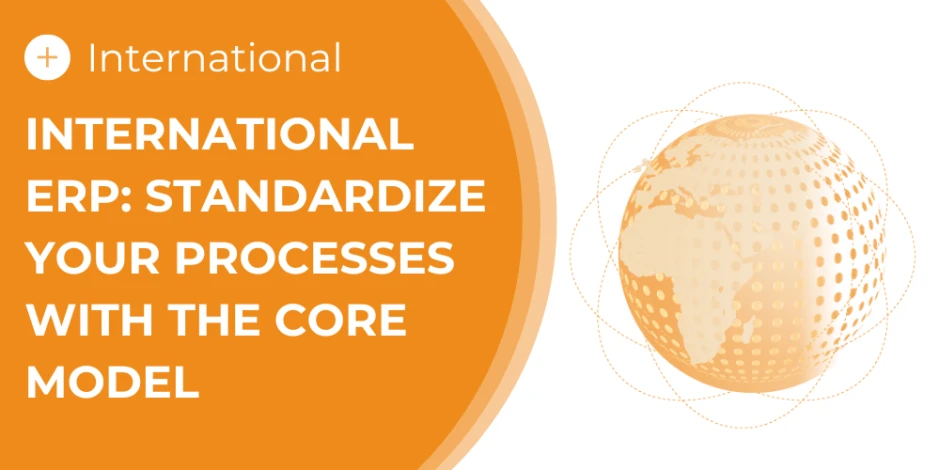International ERP: standardize your processes with the Core Model
Standardizing processes is a significant challenge for multinational companies implementing an ERP system internationally. The Core Model is widely recognized as the most effective solution to harmonize operations while accommodating local specificities. Discover how this approach enables companies to standardize processes, reduce costs, and optimize decision-making.
08 October 2024
The Core Model: Definition
The Core Model is an approach that defines a set of standardized and centralized processes for all of a company’s subsidiaries. In practice, it involves creating a single reference model while allowing local adaptations when necessary. This strategy is especially suited for multinational companies aiming to align their processes on a global scale.
During the deployment of an international ERP, the Core Model plays a crucial role. It serves as the foundation for configuring the information system, defining the key processes that will be used by all company entities. These may include aspects such as financial and accounting management, production, or human resources management. By using the Core Model, multinationals ensure that each subsidiary operates according to optimized standards and practices while maintaining some flexibility for local adjustments.
Implementing a Core Model for an international ERP offers numerous advantages, such as cost reduction and simplifying operational management. However, it is also a complex process that requires precise planning and careful execution to ensure success.
Discover Absys Cyborg Global SolutioNS
Benefits of the Core Model for International ERP Deployment
Process Standardization
One of the main advantages of the Core Model is the standardization of processes across all company entities. By defining common processes, multinational companies can ensure operational consistency, which facilitates management, monitoring, and activity control. This results in greater operational efficiency, improved visibility, and fewer errors.
Moreover, standardizing the information system enhances collaboration between subsidiaries, as they now share a common language and similar tools.
Cost and Risk Reduction
The Core Model method also enables multinationals to achieve economies of scale. By centralizing processes and tools, it reduces costs related to training, maintenance, and support.
Additionally, standardized processes help reduce risks. With a centralized approach, multinational companies can better control operations and ensure compliance with local and international regulations. This is particularly important in sectors like financial services, where legal requirements vary from country to country. The Core Model also facilitates auditing and operational traceability, thus reducing the risk of errors and fraud.
Improved Decision-Making
A well-defined Core Model provides companies with a global view of their operations. Executives can easily compare the performance of different subsidiaries, identify trends, and address areas that need improvement. In short, this visibility enables more agility and responsiveness.
How to Implement a Core Model for a Successful Project
Building the Core Model
The first step is to conduct a thorough analysis of the company’s needs and processes. It is essential to understand the operations of each subsidiary, identify key processes to standardize, and determine areas requiring local adaptation.
Specific developments may need to be identified to ensure the model's agility. This might involve integrating a vertical solution or adding an add-on.
Implementation and Adaptation
Once the analysis is completed, the next step is to develop and implement the Core Model. This involves configuring the ERP solution according to the defined processes while ensuring enough flexibility for local adjustments. Some ERPs are particularly well-suited to this approach, such as Microsoft’s Business Central and Sage X3.
A key factor for success at this stage is striking the right balance between standardization and adaptation. The Core Model must be robust enough to ensure global consistency but flexible enough to allow subsidiaries to meet their market's specific requirements.
Change Management and Training
Implementing a Core Model represents a major shift for teams. Therefore, change management is a critical component of the process. It is important to communicate the benefits of the Core Model, involve teams in the implementation process, and train them on the new tools and practices.
Resistance to change is common, especially in multinational companies where cultures and work practices can vary significantly. A solid training plan, combined with clear communication, can help overcome these challenges and ensure successful adoption of the new information system.
The Core Model is a strategic approach for multinational companies seeking to standardize their processes internationally through an ERP system. By centralizing and harmonizing operations, companies can achieve economies of scale, reduce risks, and improve decision-making. However, implementing a Core Model requires careful planning, thorough analysis, and effective change management.
For years, the experts of Absys Cyborg Global Solutions have been using this method to maximize its benefits and perfect its implementation, ensuring the success of international deployment projects!
